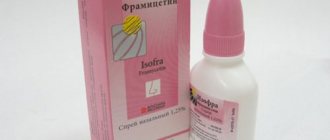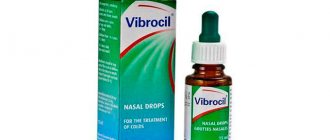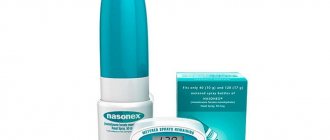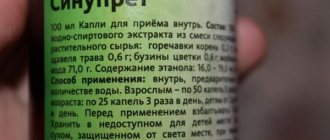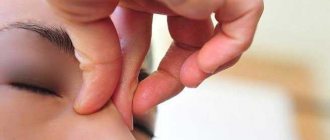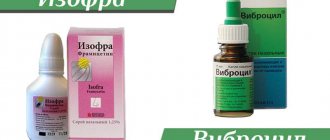Characteristics of the medicine
The basis of the drug Nasonex is the synthetic glucocorticosteroid mometasone furoate. This hormonal substance is intended for topical use and has virtually no systemic effects on the body when taken in recommended doses.
Mometasone exhibits powerful anti-inflammatory and antiallergic effects. They are based on the substance’s ability to inhibit the formation of inflammatory mediators. Due to the ability to prevent the accumulation of neutrophils, the accumulation of inflammatory exudate at the site of the inflammatory process is reduced. In addition, the drug slows down the migration of macrophages and the formation of lymphokines, which leads to inhibition of granulation and infiltration. All these processes contribute to the rapid disappearance of symptoms of the inflammatory process.
Side effects
Adverse events associated with the use of the drug (>1%) identified during clinical trials in patients with allergic rhinitis or nasal polyposis, and during post-registration use of the drug, regardless of the indication for use, are presented in Table 1. Adverse reactions are listed according to with the MedDRA systemic organ classes classification. Within each systemic organ class, adverse reactions are classified by frequency of occurrence.
Nosebleeds, as a rule, were moderate and stopped on their own, the frequency of their occurrence was slightly higher than when using placebo (5%), but equal or less than when prescribing other intranasal corticosteroids, which were used as an active control (in some of In them, the incidence of nosebleeds was up to 15%). The incidence of all other adverse events was comparable to that observed with placebo.
| The frequency of adverse reactions is established as follows: very often (≥1/10); (often (≥1/100, Systemic organ class | Often | Often | Frequency not set | |||
| Infectious and parasitic diseases | Pharyngitis, upper respiratory tract infections* | |||||
| Immune system disorders | Hypersensitivity reactions, including anaphylactic reactions, angioedema, bronchospasm, shortness of breath | |||||
| Nervous system disorders | Headache | |||||
| Visual disorders | Increased intraocular pressure, glaucoma, | |||||
| Respiratory, thoracic and mediastinal disorders | Nosebleeds** | Nosebleeds (i.e., obvious bleeding as well as blood-stained mucus or blood clots), burning sensation in the nose, irritation of the nasal mucosa, ulceration of the nasal mucosa | Perforation of the nasal septum | |||
| Gastrointestinal disorders | Pharyngeal irritation (feeling of irritation of the pharyngeal mucosa)** | Disorders of taste and smell | ||||
*identified with a frequency of “rarely” when using the drug 2 times a day for nasal polyposis
** detected when using the drug 2 times a day for nasal polyposis
Disorders of the respiratory system, chest and mediastinal organs: nosebleeds (6%), irritation of the nasal mucosa (2%), sneezing (2%).
Nervous system disorders: headache (3%).
The incidence of these adverse events in children was comparable to the incidence when using placebo.
When using intranasal corticosteroids, the development of systemic side effects is possible, especially with long-term use of intranasal corticosteroids in high doses (see section "Special instructions").
Prescription for sinusitis
Nasonex for sinusitis helps to quickly get rid of nasal congestion, relieve swelling and hyperemia of the mucous membrane, and reduce the inflammatory process in the sinuses. At the same time, nasal breathing is normalized, stagnation of secretions in the sinuses is eliminated and its removal to the outside is facilitated.
It is important to understand that Nasonex does not treat the cause of sinusitis. It only helps to get rid of unpleasant symptoms and speed up recovery with the combined use of other medications. Therefore, in case of sinusitis, it is very important to consult a doctor who can determine the cause of the disease and prescribe a full course of treatment. It may include taking antibiotics, mucolytics, vasoconstrictors, antiseptics, homeopathic and other medicines.
In the treatment of rhinitis, sinusitis, incl. caused by allergies
If your doctor prescribed you NASONEX nasal spray, and now you are looking for reviews about this spray, then I will be happy to share my observations.
My daughter was diagnosed with pansinusitis (inflammation of all sinuses) and we were seen by a pediatric ENT specialist. And despite the contraindication for this disease in children under 12 years of age (my daughter is 7), we were prescribed this drug. The first 2 weeks, 2 times a day, then - 1 time a day for a month.
This is not the only medicine that was prescribed to us, so it is difficult for me to judge how effective this or that is, but in total the treatment gave positive results. If you are interested, you can read about the homeopathic remedy that we took at the same time as Nasonex in my other review.
The drug is used as a spray. Packaged in a cardboard box along with a huge amount of instructions, most of which are special instructions. I won’t quote the instructions here; they can be easily found in any search engine, but you should definitely read them before use.
The medicine is serious, these are not ordinary drops in the nose. In order for a doctor to prescribe Nasonex, good reasons are needed. For example, we have swelling of all sinuses.
After some time, we took a blood test, and its results showed that the child was allergic to something. We went to an allergist. And while we are finding out what we are allergic to, the doctor (allergist), as well as the ENT specialist, prescribes Nasonex (for allergic rhinitis, indications for use in children over 2 years old). And we already accept it. The allergist said that this is very good in the run-up to flowering, when things get worse for allergy sufferers. She also recommended spraying Nasonex at night, citing the fact that it is at night, when we sleep, that substances that contribute to the manifestations of allergies “wake up” in the body (sorry, I’m not a doctor, so that’s what I understand, and that’s what I’m trying to convey). And in order to “dull” them, you need to spray Nasonex and take Montelast (tablets prescribed by the doctor along with Nasonex) at night. Then the whole next day will pass calmly.
Bottom line: Nasonex is an effective remedy, but only as part of a treatment prescribed by a doctor.
Price: I don’t remember the exact amount, 800-900 rubles. On average, a bottle will last for a month. The second month of use has begun according to the scheme: 2 times a day - one spray per month. 2 weeks, 1 day per day - one spray per day. month. All that's left is at the bottom, we'll buy a new one. Doctors say that it can be taken for 1 month, or 3, and in special cases - up to six months.
When your nose is clogged, nothing makes you happy. All thoughts about getting rid of the annoying runny nose. Excessive swelling that occurs with a runny nose can be a sign of a more serious illness that takes months to treat. The desire to quickly get rid of the disease forces one to urgently, often even before visiting an ENT doctor, search for effective medications. Those who are often bothered by colds, runny nose, and sinusitis will most likely recommend remedies that have already been tested on their own bodies, such as Nasonex. How to take Nasonex for sinusitis? Reviews about the drug heard from friends are sometimes more useful than the instructions. However, before using the medication, you should still go to the clinic - consult with a specialist, as well as carefully read the instructions.
Use in pediatrics
The medicine is approved for use in children over 2 years of age.
At an earlier age, the use of the drug is not recommended due to possible severe irritation of the delicate nasal mucosa of children and the lack of sufficient research on the use of the drug in this category of patients. Nasonex is especially often prescribed for green snot in a child, which signals a serious inflammatory process. This color of nasal discharge can be observed both with sinusitis and with other forms of sinusitis, rhinitis and adenoiditis.
Application of Nasonex
As mentioned earlier in contraindications for use, Nasonex can be taken by children over 2 years of age and adults.
Before use, the spray bottle must be shaken and the dosing valve must be calibrated several times for uniform release, then inserted into the nostril and through the dispenser, the medicine must be injected into the nasal passage (it is recommended to inject the drug into both nasal passages).
When treating exacerbations of chronic (vasomotor renitis), it is recommended for children aged 2 to 12 years to take 1 inhalation (1 injection) into each nasal passage, 1 time per day, which is equivalent to 50 mcg of mometasone. The maximum daily dose of mometasone for children is 100 mcg of mometasone.
For adolescents over 12 years of age and adult patients, it is recommended to use 100 mcg of mometasone (2 inhalations) in each nostril, twice a day. The maximum total daily dose for this age category is 800 mcg of mometasone (4 doses).
Features of application
The instructions for the drug contain the following information:
- Long-term use of the drug requires periodic examination of the nose to identify possible changes in its mucous membrane.
- It is forbidden to use Nasonex simultaneously with vasoconstrictor drops.
- When used for more than 2 weeks in a row, addiction to the drug may develop and its effectiveness may decrease.
- The drug is well tolerated by patients, since it practically does not enter the systemic bloodstream, which prevents the manifestation of effects on the body.
- If a fungal infection of the nose occurs or persistent irritation of the mucous membrane occurs, treatment with the drug should be discontinued.
- It is necessary to inform your doctor about all medications used to exclude possible drug interactions.
Must be used with great caution.
I will say right away that I believe that Nasonex helps many people, especially with asthma, bronchial asthma and allergic rhinitis. But there is also a reverse reaction, as in our case!
My child gets sick often and a lot. By the age of 10, she already has hr. tonsillitis, chronic adenoiditis and a runny nose that does not go away even in summer. The first time an ENT doctor prescribed us Nazonex was probably in 1st grade, after another acute respiratory viral infection. The doctor warned that the product is not cheap, but very effective, and will definitely help us. She explained how to use it and said it would take about a month. I’ll say right away that my child already knows how to rinse his nose himself, because... From the age of 3 this is the only thing that helps us at least a little.
We bought it and started trying it. Having squirted only once, by the end of the day I noticed that the child’s snot was much less. I was surprised, I thought it couldn’t be like this - it’s a miracle! On the second day there was no snot at all, even after washing my nose, nothing came out of it. I continued to be happy and surprised. The next day there was no snot either, but my daughter’s face became swollen, especially in the morning under the eyes. Another day later, the temperature rose, and I realized that there was no snot due to banal swelling of the mucous membrane, and the snot did not even flow down the back of the throat (as usually happens). As a result, bilateral acute catarrhal sinusitis, vasoconstrictors, antibiotics. long treatment.
So we continue to suffer with our nose to this day. And every time I visit the ENT specialist and cure another rhinopharyngitis, laryngitis or acute respiratory viral infection, I hear: “now after treatment, use Nasonex .”
Several more times, deciding that we simply had not treated the infection and after persuading the doctors that this was a miracle remedy, I again tried to use Nasonex, but after 3 days the child had the same reaction, global EDEMA. Taught by previous experience, I already saw all the signs of swelling on my face, stopped using Nasonex, started giving anti-allergy drugs, vasoconstrictors, and intensively washed out the mucus accumulated as a result of swelling in huge quantities.
Every time I talked about such a reaction to the doctors, they objected to me that this cannot be, Nazanex is a super drug, it can cause such a reaction, but VERY rarely, you need to complete the entire course to the end. Once again, a year ago in the summer, when my mother-in-law was at an appointment with my daughter, the doctor again sold us Nazanex. And once again, after 4 days of taking it, we got acute sinusitis. with high temperature and other delights.
I’m writing because I’m sick, 3 days ago we again finished treatment for another serious sinusitis, after our endless winter illnesses, and again from the doctor I heard the familiar: “and now Nasonex. “, I note that the child does not have nasal congestion, just chronic snot. there is a lot of mucus that comes off easily, while the nose becomes nauseous. I immediately refused to take it and described all the symptoms associated with the use of this remedy. Again I heard the doctor’s surprised exclamations that this couldn’t be happening. As a result, we were prescribed an analogue: Tafen nasal - cheaper. That's it - I have no words.
Why would a non-asthmatic child need such medications?
- Are there really no other drugs to treat chronic disease? rhinitis and sinusitis except NASONEX and the like?
- Is it really true that a child’s reaction to a widely advertised and expensive drug means nothing for contraindications for use?
- Nasonex DOES NOT TREAT a runny nose, adenoids, or throat.
- Perhaps NASONEX helps with allergies, asthma, etc., but we do not have these diseases and, on the contrary, it causes swelling, which in turn causes sinusitis.
I can also add that two parents offered to give me Nasonex (for free), since “there’s an expensive drug lying around the house that doesn’t help at all. maybe it will help you. “But I myself have this and it’s good that it simply doesn’t help someone.
source


